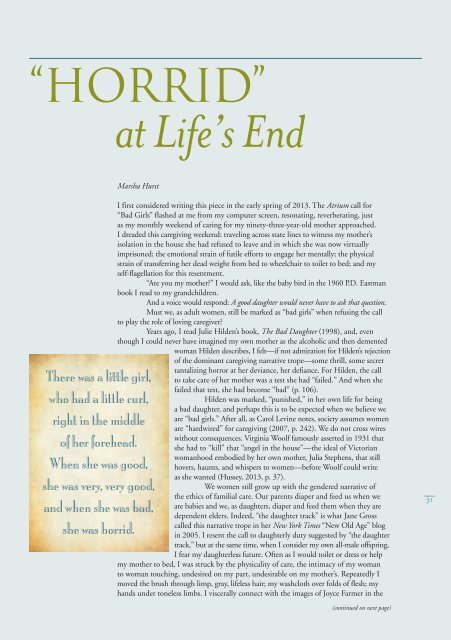atrium-issue-12-BadGirls
atrium-issue-12-BadGirls
atrium-issue-12-BadGirls
Create successful ePaper yourself
Turn your PDF publications into a flip-book with our unique Google optimized e-Paper software.
“Horrid”<br />
at Life’s End<br />
Marsha Hurst<br />
There was a little girl,<br />
who had a little curl,<br />
right in the middle<br />
of her forehead.<br />
When she was good,<br />
she was very, very good,<br />
and when she was bad,<br />
she was horrid.<br />
I first considered writing this piece in the early spring of 2013. The Atrium call for<br />
“Bad Girls” flashed at me from my computer screen, resonating, reverberating, just<br />
as my monthly weekend of caring for my ninety-three-year-old mother approached.<br />
I dreaded this caregiving weekend: traveling across state lines to witness my mother’s<br />
isolation in the house she had refused to leave and in which she was now virtually<br />
imprisoned; the emotional strain of futile efforts to engage her mentally; the physical<br />
strain of transferring her dead weight from bed to wheelchair to toilet to bed; and my<br />
self-flagellation for this resentment.<br />
“Are you my mother?” I would ask, like the baby bird in the 1960 P.D. Eastman<br />
book I read to my grandchildren.<br />
And a voice would respond: A good daughter would never have to ask that question.<br />
Must we, as adult women, still be marked as “bad girls” when refusing the call<br />
to play the role of loving caregiver?<br />
Years ago, I read Julie Hilden’s book, The Bad Daughter (1998), and, even<br />
though I could never have imagined my own mother as the alcoholic and then demented<br />
woman Hilden describes, I felt—if not admiration for Hilden’s rejection<br />
of the dominant caregiving narrative trope—some thrill, some secret<br />
tantalizing horror at her deviance, her defiance. For Hilden, the call<br />
to take care of her mother was a test she had “failed.” And when she<br />
failed that test, she had become “bad” (p. 106).<br />
Hilden was marked, “punished,” in her own life for being<br />
a bad daughter, and perhaps this is to be expected when we believe we<br />
are “bad girls.” After all, as Carol Levine notes, society assumes women<br />
are “hardwired” for caregiving (2007, p. 242). We do not cross wires<br />
without consequences. Virginia Woolf famously asserted in 1931 that<br />
she had to “kill” that “angel in the house”—the ideal of Victorian<br />
womanhood embodied by her own mother, Julia Stephens, that still<br />
hovers, haunts, and whispers to women—before Woolf could write<br />
as she wanted (Hussey, 2013, p. 37).<br />
We women still grow up with the gendered narrative of<br />
the ethics of familial care. Our parents diaper and feed us when we<br />
are babies and we, as daughters, diaper and feed them when they are<br />
dependent elders. Indeed, “the daughter track” is what Jane Gross<br />
called this narrative trope in her New York Times “New Old Age” blog<br />
in 2005. I resent the call to daughterly duty suggested by “the daughter<br />
track,” but at the same time, when I consider my own all-male offspring,<br />
I fear my daughterless future. Often as I would toilet or dress or help<br />
my mother to bed, I was struck by the physicality of care, the intimacy of my woman<br />
to woman touching, undesired on my part, undesirable on my mother’s. Repeatedly I<br />
moved the brush through limp, gray, lifeless hair; my washcloth over folds of flesh; my<br />
hands under toneless limbs. I viscerally connect with the images of Joyce Farmer in the<br />
31<br />
(continued on next page)


